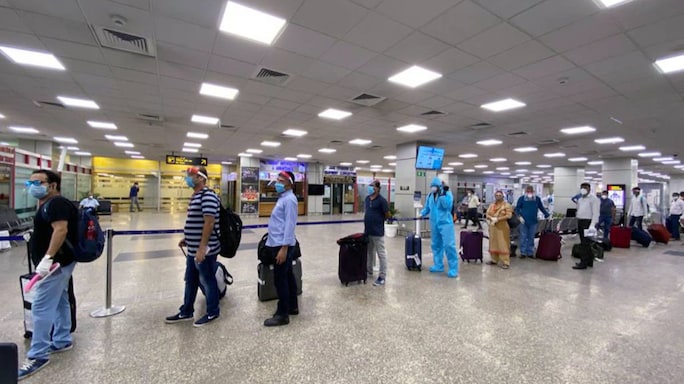- HOME
- /
- Features
- /
- Current Affairs
- /
What To Expect When You Must Take A Flight
Dressed like a cross between a wannabe surgeon and an astronaut, she entered the airport. Here’s what happened next
 ANI
ANI
I’m not particularly adventurous—you wouldn’t find me on an expedition, where I was likely to face danger and discomfort. Yet, a day after flights to Kolkata resumed following serial lockdowns, I was on a flight from Delhi to Kolkata, dressed like a cross between a wannabe surgeon and an astronaut. Gloved and masked, with a blue surgical cap on my head and a face shield that yielded additional protection to my bemasked mien, I proceeded towards the aircraft, nervously wondering if I had managed to evade the coronavirus at the airport and would also do so during the two-hour flight.
So why did I venture forth on this potentially hazardous journey? The lockdown had left my elderly mother without any help in Kolkata. She was doing poorly, and I, living in Delhi, couldn’t reach her. Of course, this was in no way comparable to the catastrophic suffering that the unplanned, unthinking shutdown had inflicted on migrant workers, but I have no shame in admitting that I was going slightly nuts and even contemplating a road journey to Kolkata.
You can imagine my relief when it was announced that domestic flights would start operating. I decided to fly out the very next day. Flying in the time of Covid-19 is all about boning up on the SOPs. And these, like Shakespeare’s Cleopatra, are of infinite variety, differing from state to state, airport to airport. You have to be clear about the rules at your point of embarkation and disembarkation. And the rules are liable to change, so you need to keep a close watch on them. Will it be quarantine or no quarantine, institutional quarantine or home, for two weeks, or longer, and so on.
Anyway, come D-Day, I arrived at Delhi airport, duly kitted out in corona-resistant gear, had a largish bottle of hand sanitizer in my bag, and extra masks, too, just in case. I lowered my mask just once on the entire trip—when I was required to show my face to the security person at the entrance so he could match it with my photo ID.
I knew the Aarogya Setu app was not mandatory for flying (the aviation minister had said as much), but I had taken care to download it on my phone. I had a hunch that the burly security blokes at Delhi airport would demand to see it even if I passed the temperature check. And I didn’t relish the prospect of a lengthy argument with them. Turned out that I was right—they did want to see the all-clear on my app before waving me through, which was rather droll, considering I could have lied about my health on the app, and the digital marvel wouldn’t have known it.
For me, the best part of flying in this post-Covid world was that at long last, I could rightfully demand that my fellow passengers respect my physical space. Social distancing norms meant that I did not have to snap at someone behind me in a queue for crowding into me and breathing into my neck. I was also chuffed when I put my baggage into the sanitization channel that glowed with ultra violet or some such light. Take that, you virus, you! — I jeered at the invisible enemy. However, that feeling of triumph evaporated when I reached security check and saw that the ‘sanitized’ cabin baggage was being scraped along into the X-ray machine just as before—picking up a galaxy of germs and viruses.
 ANI
ANI
I did wonder afterwards if I should give my backpack and hand bag a wipe with some hand sanitizer, but decided against it, as I was running low on the stuff, thanks to repeated and obsessive sanitizing of my gloved hands. I must have sanitized my hands at least eight to 10 times at the airport washroom alone, because any attempt at remaining contactless goes for a toss there. Still, it was infinitely preferable to the Lilliputian aircraft toilet. Others must have had the same thought, because I did not see a single passenger use the loo on the flight.
In fact, inside the aircraft, everyone seemed to have turned into stone. The spectral, white PPE-clad flight attendants disappeared somewhere. And in the shadowy cabin, no one stirred, not a word could be heard, not even a baby howled. It seemed as if the virus had us in its thrall. And we sat there, tense and apprehensive, perhaps silently praying that it would spare us.
I was quite ravenous by now, not having eaten anything at the airport for fear of contamination, even though I knew that no food would be served on the aircraft. I began to think wistfully about the sub-par airline food that I had so disdained once.
But then, almost nothing was the way it used to be. When the flight landed, the passengers disembarked slowly, quietly. No one was shouting into their phone to tell someone they had landed. (The masks do make high-decibel conversation difficult.) At the airport, there were long, snaking queues of passengers, who were being temperature-checked before they were allowed to exit the building. And those queues seemed surprisingly well-ordered, too—no one was trying to jump or barge in.
I don’t know if this sombre, subdued mood will last among air travellers, but on that day, at least, all of us seemed sharply aware that our old way of life was gone, and there was no knowing when we would reclaim it.
Shuma Raha is a journalist and author






